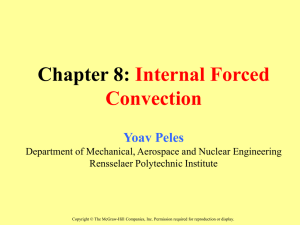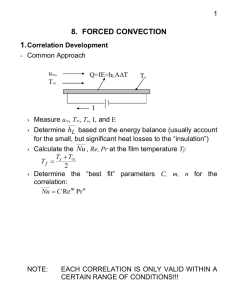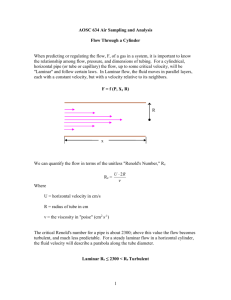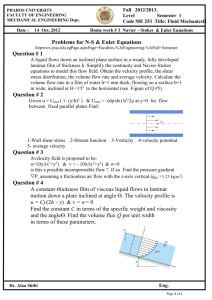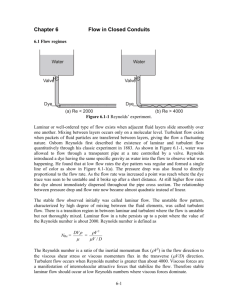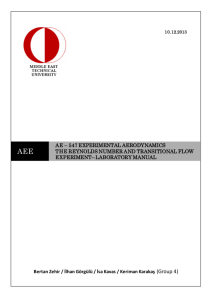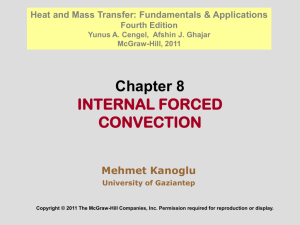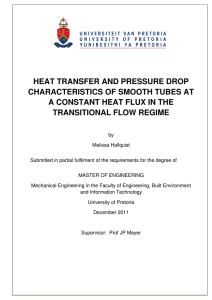Chapter 8: Internal Forced Convection
advertisement
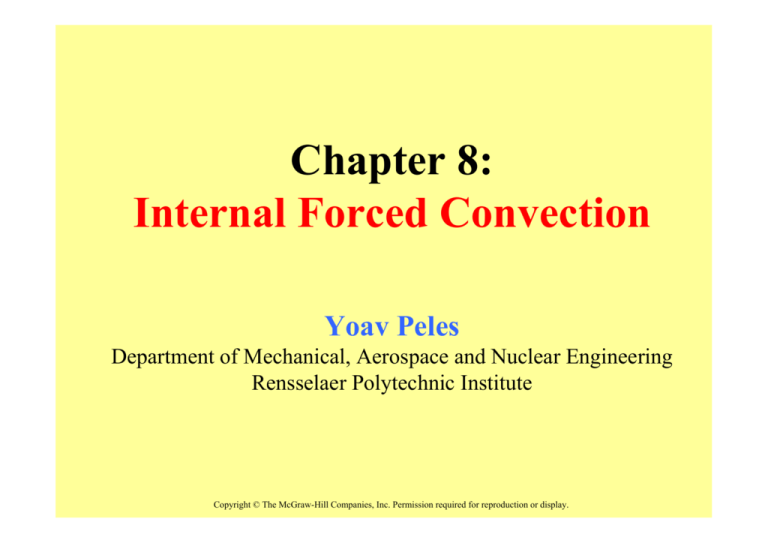
Chapter 8: Internal Forced Convection Yoav Peles Department of Mechanical, Aerospace and Nuclear Engineering Rensselaer Polytechnic Institute Copyright © The McGraw-Hill Companies, Inc. Permission required for reproduction or display. Objectives When you finish studying this chapter, you should be able to: • Obtain average velocity from a knowledge of velocity profile, and average temperature from a knowledge of temperature profile in internal flow, • Have a visual understanding of different flow regions in internal flow, such as the entry and the fully developed flow regions, and calculate hydrodynamic and thermal entry lengths, • Analyze heating and cooling of a fluid flowing in a tube under constant surface temperature and constant surface heat flux conditions, and work with the logarithmic mean temperature difference, • Obtain analytic relations for the velocity profile, pressure drop, friction factor, and Nusselt number in fully developed laminar flow, and • Determine the friction factor and Nusselt number in fully developed turbulent flow using empirical relations, and calculate the pressure drop and heat transfer rate. Introduction • Pipe ─ circular cross section. • Duct ─ noncircular cross section. • Tubes ─ small-diameter pipes. • The fluid velocity changes from zero at the surface (no-slip) to a maximum at the pipe center. • It is convenient to work with an average velocity, which remains constant in incompressible flow when the cross-sectional area is constant. Average Velocity • The value of the average velocity is determined from the conservation of mass principle m = ρVavg AC = ∫ ρ u ( r ) dAC (8-1) Ac • For incompressible flow in a circular pipe of radius R ∫ ρ u ( r ) dA C Vavg = Ac ρ AC ∫ = R 0 ρ u ( r ) 2π rdr ρπ R 2 R 2 = 2 ∫ u ( r ) rdr R 0 (8-2) Average Temperature • It is convenient to define the value of the mean temperature Tm from the conservation of energy principle. • The energy transported by the fluid through a cross section in actual flow must be equal to the energy that would be transported through the same cross section if the fluid were at a constant temperature Tm pTm = ∫ c pT ( r ) δ m = E fluid = mc m ∫ ρ c T ( r ) u ( r )VdA p Ac c (8-3) • For incompressible flow in a circular pipe of radius R Tm = ∫ c pT ( r ) δ m m p mc ∫ c T ( r ) ρ u ( r ) 2π rdr p = Ac ρVavg (π R 2 ) c p (8-4) R 2 = T ( r ) u ( r ) rdr 2 ∫ Vavg R 0 • The mean temperature Tm of a fluid changes during heating or cooling. Idealized Actual Laminar and Turbulent Flow in Tubes • For flow in a circular tube, the Reynolds number is defined as ρVavg D Vavg D (8-5) Re = = µ ν • For flow through noncircular tubes D is replaced by the hydraulic diameter Dh. 4 Ac Dh = P (8-6) • laminar flow: Re<2300 • Transitional flow: 2300 ≤ Re ≤ 10,000 • fully turbulent flow : Re>10,000. The Entrance Region • A fluid entering a circular pipe at a uniform velocity. • The no-slip condition - the flow in a pipe is divided into two regions: – (i) boundary layer region, (ii) irrotational (core) flow region • The thickness of this boundary layer increases in the flow direction until it reaches the pipe center. Irrotational flow Boundary layer • Hydrodynamic entrance region ─ the region from the pipe inlet to the point at which the boundary layer merges at the centerline. • Hydrodynamically fully developed region ─ the region beyond the entrance region in which the velocity profile is fully developed and remains unchanged. • The velocity profile in the fully developed region is – parabolic in laminar flow, and – somewhat flatter or fuller in turbulent flow. Thermal Entrance Region • Consider a fluid at a uniform temperature entering a circular tube whose surface is maintained at a different temperature. • Thermal boundary layer along the tube is developing. • The thickness of this boundary layer increases in the flow direction until the boundary layer reaches the tube center. • Thermal entrance region. • Thermally fully developed region ─ the region beyond the thermal entrance region in which the dimensionless temperature profile expressed as (Ts-T)/(Ts-Tm) remains unchanged. – Hydrodynamically fully-developed: ∂u ( r , x ) ∂x = 0 → u = u (r ) (8-7) – Thermally fully-developed: ∂ ⎡ Ts ( x ) − T ( r , x ) ⎤ ⎢ ⎥=0 ∂x ⎢⎣ Ts ( x ) − Tm ( x ) ⎥⎦ (8-8) − ( ∂T ∂r ) r = R ∂ ⎛ Ts − T ⎞ = ≠ f ( x ) (8-9) ⎜ ⎟ Ts − Tm ∂r ⎝ Ts − Tm ⎠ r = R 常數 應為常數 • Surface heat flux can be expressed as k ( ∂T ∂r ) r = R ∂T qs = hx (Ts − Tm ) = k → hx = (8-10) ∂ r T − T r=R s m h 之定義 • For thermally fully developed region From (Eq. (8-9)) ( ∂T ∂r ) r = R Ts − Tm ≠ f ( x) hx ≠ f ( x ) Fully developed flow hx = constant Fully developed flow Heat Transfer coefficient and Friction factor Developing region Lh 與 Lt 何者較長? Fully developed region Entry Lengths (入口區域) Laminar flow – Hydrodynamic Lh ,laminar ≈ 0.05 Re⋅ D (8-11) – Thermal Lt ,laminar ≈ 0.05 Re⋅ Pr⋅ D = Pr⋅ Lh ,laminar (8-12) Turbulent flow – Hydrodynamic Lh ,turbulent = 1.359 D ⋅ Re (8-13) – Thermal (approximate) Lh ,turbulent ≈ Lt ,turbulent ≈ 10 D (8-14) 14 Turbulent flow Nusselt Number • The Nusselt numbers are much higher in the entrance region. • The Nusselt number reaches a constant value at a distance of less than 10 diameters. • The Nusselt numbers for the uniform surface temperature and uniform surface heat flux conditions are identical in the fully developed regions, and nearly identical in the entrance regions. Æ Nusselt number is insensitive to the type of thermal boundary condition. General Thermal Analysis • In the absence of any work interactions, the conservation of energy equation for the steady flow of a fluid in a tube p (Te − Ti ) Q = mc (W) (8-15) • The thermal conditions at the surface can usually be approximated as: – constant surface temperature, or – constant surface heat flux. • The mean fluid temperature Tm must change during heating or cooling. • Either Ts= constant or qs = constant at the surface of a tube, but not both. Constant Surface Heat Flux • In the case of constant heat flux, the rate of heat transfer can also be expressed as (8-17) p (Te − Ti ) (W) Q = qs As = mc • Then the mean fluid temperature at the tube exit becomes qs As (8-18) Te = Ti + p mc • The surface temperature in the case of constant surface heat flux can be determined from qs (8-19) qs = h (Ts − Tm ) → Ts = Tm + h h 之定義 • In the fully developed region, the surface temperature Ts will also increase linearly in the flow direction • Applying the steady-flow energy balance to a tube slice of thickness dx, the slope of the mean fluid temperature Tm can be determined dTm qs p p dTm = qs ( pdx ) → mc = = constant p dx mc • Noting that both the heat flux and h (for fully developed flow) are constants 由式 (8-19) 微分可得: dTm dTs = dx dx (8-21) (8-20) • In the fully developed region (Ts-Tm=constant) ∂ ⎛ Ts − T ⎜ ∂x ⎝ Ts − Tm ⎞ ∂T dTs 1 ⎛ ∂Ts ∂T ⎞ − =0→ = ⎟=0→ ⎜ ⎟ Ts − Tm ⎝ ∂x ∂x ⎠ ∂x dx ⎠ (8-22) • Combining Eqs. 8–20, 8–21, and 8–22 gives ∂T dTs dTm qs p = = = = constant p ∂x dx dx mc (8-23) • For a circular tube ( p = 2πR = πD ) 2qs ∂T dTs dTm = = = = constant (8-24) ∂x dx dx ρVavg c p R Constant Surface Temperature • The energy balance on a differential control volume p dTm = h (Ts − Tm ) dAs δ Q = mc (8-27) • Since the mean temperature of the fluid Tm increases in the flow direction, the heat flux decays with x. • The surface temperature is constant (dTm=-d(Ts-Tm)) and dAs=pdx, therefore, d (Ts − Tm ) Ts − Tm hp =− dx p mc (8-28) • Integrating Eq. 6-28 from x=0 (tube inlet where Tm=Ti) to x=L (tube exit where Tm=Te) gives Ts − Te hAs ln =− p Ts − Ti mc (8-29) • Taking the exponential of both sides and solving for Te p) Te = Ts − (Ts − Ti ) exp ( − hpL mc • or p) Tm ( x ) = Ts − (Ts − Ti ) exp ( − hpx mc 任何位置 x 之平均溫度 (8-30) • The temperature difference between the fluid and the surface decays exponentially in the flow direction, and the rate of decay depends on the magnitude of the exponent p hAs mc • This dimensionless parameter is called the number of transfer units (NTU). – Large NTU value – increasing tube length marginally increases heat transfer rate. – Small NTU value – heat transfer increases significantly with increasing tube length. • Solving Eq. 8–29 for mcp gives p= mc hAs ln ⎡⎣(Ts − Te ) (Ts − Ti ) ⎤⎦ (8-31) • Substituting this into Eq. 8–15 p (Te − Ti ) Q = mc (W) Q = hAs ∆Tln (8-32) where Ti − Te ∆Te − ∆Ti ∆Tln = = ln ⎡⎣(Ts − Te ) (Ts − Ti ) ⎤⎦ ln [ ∆Te ∆Ti ] ∆Τln is the logarithmic mean temperature difference. (8-33) Laminar Flow in Tubes • • • • • Assumptions: steady laminar flow, incompressible fluid, constant properties, fully developed region, and straight circular tube. • The velocity profile u(r) remains unchanged in the flow direction. • no motion in the radial direction. • no acceleration. • Consider a ring-shaped differential volume element. • A force balance on the volume element in the flow direction gives ( 2π r dr P ) x − ( 2π r dr P ) x+ dx + ( 2π r dx τ )r − ( 2π r dx τ )r + dr = 0 (8-34) • Dividing by 2π dr dx and rearranging Px + dx − Px ( rτ )r + dr − ( rτ )r r + =0 dx dr (8-35) • Taking the limit as dr, dx → 0 gives dP d ( rτ ) r + =0 dx dr (8-36) • Substituting τ = µ(du/dr) gives µ d ⎛ du ⎞ dP ⎜r ⎟= r dr ⎝ dr ⎠ dx (8-37) • Rearranging and integrating it twice to give • 1 ⎛ dP ⎞ 2 u (r ) = ⎜ ⎟ r + C1 ln r + C2 4 µ ⎝ dx ⎠ 漏印 Boundary Conditions: (8-38) – symmetry about the centerline : ∂u/∂r = 0 at r = 0, – no-slip condition: u = 0 at r = R. • Eq. 6-38 with the boundary conditions R 2 ⎛ dP ⎞ ⎛ r2 ⎞ u (r ) = − ⎜ ⎟ ⎜1 − 2 ⎟ 4 µ ⎝ dx ⎠ ⎝ R ⎠ (8-39) • Substituting Eq. 8–39 into Eq. 8–2, and performing the integration gives the average velocity Vavg R R 2 2 R 2 ⎛ dP ⎞ ⎛ r2 ⎞ = 2 ∫ u ( r ) rdr = − 2 ∫ ⎜ ⎟ ⎜1 − 2 ⎟ rdr R 0 R 0 4 µ ⎝ dx ⎠ ⎝ R ⎠ R 2 ⎛ dP ⎞ =− ⎜ ⎟ 8µ ⎝ dx ⎠ (8-40) • Combining the last two equations, the velocity profile is rewritten as ⎛ r2 ⎞ u ( r ) = 2Vavg ⎜1 − 2 ⎟ ⎝ R ⎠ ; umax = 2Vavg (8-41) Pressure Drop • One implication from Eq. 8-37 is that the pressure drop gradient (dP/dx) must be constant (the left side is a function only of r, and the right side is a function only of x). • Integrating from x=x1 where the pressure is P1 to x=x1=L where the pressure is P2 gives (速度場完全發展區域) P2 − P1 dP = constant = dx L (8-43) • Substituting Eq. 8–43 into the Vavg expression in Eq. 8–40 ∆P = P1 − P2 = 8µ LVavg R 2 = 32 µ LVavg D 2 (8-44) • A pressure drop due to viscous effects represents an irreversible pressure loss. • It is convenient to express the pressure loss for all types of fully developed internal flows in terms of the dynamic pressure and the friction factor dynamic pressure P f friction factor ∆PL = ( P1 − P2 ) = L ⋅ ⋅ D P 2 ρVavg (8-45) 2 • Setting Eqs. 8–44 and 8–45 equal to each other and solving for f gives – Circular tube, laminar: 64 µ 64 f = = ρ DVavg Re (8-46) Temperature Profile and the Nusselt Number • Energy is transferred by mass in the x-direction, and by conduction in the r-direction. • The steady flow energy balance for a cylindrical shell element can be expressed as: pTx − mc pTx + dx + Q r − Q r + dr = 0 mc 入 出 • Substituting 入 (8-49) 出 m = ρ uAc = ρ u ( 2π rdr ) = 質量流率 and dividing by 2πr dr dx gives, after rearranging Tx + dx − Tx Q r + dr − Q r 1 ) = −( )( ) ρ c pu ( 2π rdx dx dr (8-50) • Or ∂T 1 ∂Q u = −( ) 2 ρ c pπ rdx ∂r ∂x (8-51) • Since Fourier’s Law (完全發展區域) ∂Q ∂ ⎛ ∂T = ⎜ − k (2π rdx) ∂r ∂r ⎝ ∂r ∂ ⎛ ∂T ⎞ ⎞ ⎟ = −2π kdx ⎜ r ⎟ ∂ ∂ r r ⎠ ⎝ ⎠ (8-52) Eq 8-51 becomes (能量平衡公式 – Energy Equation) ∂T α ∂ ⎛ ∂T ⎞ = u ⎜r ⎟ ∂x r dr ⎝ ∂r ⎠ ; k α= ρcp (8-53) Constant Surface Heat Flux – Laminar Fully Developed flow • Substituting Eqs. 8-24 and 8-41 into Eq. 8.53 ⎛ r2 ⎞ u ( r ) = 2Vavg ⎜1 − 2 ⎟ ⎝ R ⎠ 2qs ∂T = = constant ∂x ρVavg c p R (8-41) (8-24) ∂T α ∂ ⎛ ∂T ⎞ u = ⎜r ⎟ ∂x r dr ⎝ ∂r ⎠ 4qs kR (8-53) ⎛ r 2 ⎞ 1 d ⎛ dT ⎞ (8-55) 常微分 ⎜1 − 2 ⎟ = ⎜r ⎟ 方程式 ⎝ R ⎠ r dr ⎝ dr ⎠ • Separating the variables and integrating twice qs ⎛ 2 r 4 ⎞ T= ⎜ r − 2 ⎟ + C1r + C2 kR ⎝ 4R ⎠ (8-56) • Boundary conditions – Symmetry at r = 0: – At r = R: ∂T ( r = 0 ) ∂r =0 T(r=R) = Ts qs R ⎛ 3 r 2 r4 ⎞ T = Ts − ⎜ − 2+ 4⎟ k ⎝4 R 4R ⎠ C1=0 C2 (8-57) • Substituting the velocity and temperature profile relations (Eqs. 8–41 and 8–57) into Eq. 8–4 and performing the integration ∫ c T ( r ) δ m ∫ c T ( r ) ρ u ( r ) 2π rdr p p Tm = 平均流體溫度 = m p mc = Ac ρVavg (π R 2 ) c p R 2 = T ( r ) u ( r ) rdr 2 ∫ Vavg R 0 (8-58) 11 qs R Tm = Ts − 24 k (8-4) qs ≡ h (Ts − Tm ) 24 k 48 k k h= = = 4.36 11 R 11 D D (8-59) Constant heat flux (circular tube, laminar) hD Nu = = 4.36 = 常數 k (8-60) Constant Surface temperature (circular tube, laminar) hD Nu = = 3.66 k 推導較複雜(研究所) (8-61) Laminar Flow in Noncircular Tubes • The friction factor ( f ) and the Nusselt number relations are given in Table 8–1 for fully developed laminar flow in tubes of various cross sections. Laminar flow – Hydrodynamic – Thermal Lh ,laminar ≈ 0.05 Re⋅ D Lt ,laminar ≈ 0.05 Re⋅ Pr⋅ D = Pr⋅ Lh ,laminar Developing Laminar Flow in the Entrance Region • For a circular tube of length L subjected to constant surface temperature, the average Nusselt number for the thermal entrance region (hydrodynamically developed flow) Nu = 3.66 + 0.065 ( D L ) Re⋅ Pr 1 + 0.04 ⎡⎣( D L ) Re⋅ Pr ⎤⎦ 23 (8-62) • For flow between isothermal parallel plates Nu = 7.54 + 0.03 ( Dh L ) Re⋅ Pr 1 + 0.016 ⎡⎣( Dh L ) Re⋅ Pr ⎤⎦ 23 (8-64) Turbulent flow in Tubes • Most correlations for the friction and heat transfer coefficients in turbulent flow are based on experimental studies. • For smooth tubes, the friction factor in turbulent flow can be determined from the explicit first Petukhov equation f = ( 0.79 ln Re− 1.64 ) −2 3000<Re<5 × 106 (8-65) • For fully developed turbulent flow the Nusselt number (Dittus–Boelter equation) n = 0.4 heating ⎫ 0.8 n ⎧ Re > 10, 000 Nu = 0.023Re Pr ⎨ ⎬ ⎩0.7 ≤ Pr ≤ 160 n = 0.3 cooling ⎭ (8-68) • Modified correlations are available for/due to : – liquid metals (Pr<<1), – large variation in fluid properties due to a large temperature difference, – surface roughness, – flow through tube annulus. • Original correlations are also approximately valid for: – developing Turbulent Flow in the Entrance Region, – turbulent Flow in Noncircular Tubes. Moody Diagram

